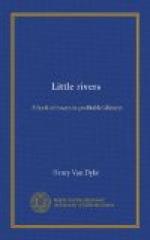“Flowing with a smooth brown current.”
And in this sheet of burnished bronze the mountains and islands were reflected perfectly, and the sun shone back from it, not in broken gleams or a wide lane of light, but like a single ball of fire, moving before us as we moved.
But stop! What is that dark speck on the water, away down toward Turtle Point? It has just the shape and size of a deer’s head. It seems to move steadily out into the lake. There is a little ripple, like a wake, behind it. Hose turns to look at it, and then sends the boat darting in that direction with long, swift strokes. It is a moment of pleasant excitement, and we begin to conjecture whether the deer is a buck or a doe, and whose hounds have driven it in. But when Hose turns to look again, he slackens his stroke, and says: “I guess we needn’t to hurry; he won’t get away. It’s astonishin’ what a lot of fun a man can get in the course of a natural life a-chasm’ chumps of wood.”
We landed on a sand beach at the mouth of a little stream, where a blazed tree marked the beginning of the Ampersand trail. This line through the forest was made years ago by that ardent sportsman and lover of the Adirondacks, Dr. W. W. Ely, of Rochester. Since that time it has been shortened and improved a little by other travellers, and also not a little blocked and confused by the lumbermen and the course of Nature. For when the lumbermen go into the woods, they cut roads in every direction, leading nowhither, and the unwary wanderer is thereby led aside from the right way, and entangled in the undergrowth. And as for Nature, she is entirely opposed to continuance of paths through her forest. She covers them with fallen leaves, and hides them with thick bushes. She drops great trees across them, and blots then out with windfalls. But the blazed line—a succession of broad axe-marks on the trunks of the trees, just high enough to catch the eye on a level—cannot be so easily obliterated, and this, after all, is the safest guide through the woods.
Our trail led us at first through a natural meadow, overgrown with waist-high grass, and very spongy to the tread. Hornet-haunted also was this meadow, and therefore no place for idle dalliance or unwary digression, for the sting of the hornet is one of the saddest and most humiliating surprises of this mortal life.
Then through a tangle of old wood-roads my guide led me safely, and we struck one of the long ridges which slope gently from the lake to the base of the mountain. Here walking was comparatively easy, for in the hard-wood timber there is little underbrush. The massive trunks seemed like pillars set to uphold the level roof of green. Great yellow birches, shaggy with age, stretched their knotted arms high above us; sugar-maples stood up straight and proud under their leafy crowns; and smooth beeches—the most polished and parklike of all the forest trees—offered opportunities for the carving of lovers’ names in a place where few lovers ever come.




